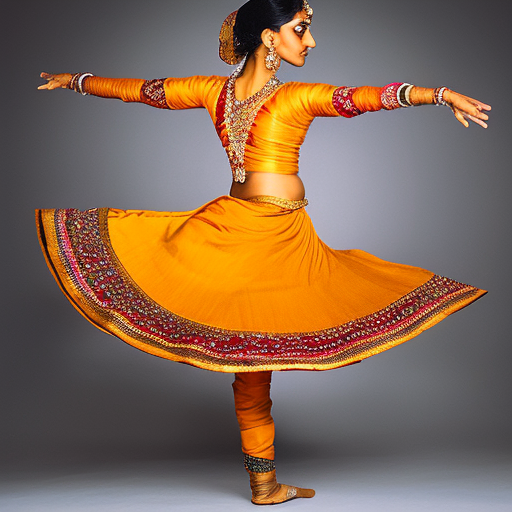Summary: Kathak is one of the eight classical dance forms of India, originating from the northern region of the country. It is a dynamic and expressive dance style that combines intricate footwork, graceful movements, and storytelling. Kathak has evolved over centuries, blending elements of Hindu and Muslim cultures, and has become a popular and respected art form worldwide.
Origins and History
Kathak has its roots in the ancient Hindu temples of northern India, where it was performed by devadasis (temple dancers) as a form of worship. Over time, it evolved and incorporated influences from the Mughal courts during the medieval period. The dance form gained prominence during the Bhakti movement in the 15th and 16th centuries when it became a means of expressing devotion to Hindu deities, particularly Lord Krishna.
Technique and Style
Kathak is characterized by its intricate footwork, rhythmic patterns, and graceful movements. The dancer wears ankle bells called ghungroos, which produce rhythmic sounds as they move. The dance style emphasizes both nritta (pure dance) and abhinaya (expressive storytelling). Nritta involves complex footwork, spins, and rhythmic patterns, while abhinaya focuses on conveying emotions and narratives through facial expressions, hand gestures, and body movements.
Costumes and Jewelry
Kathak dancers typically wear colorful and embellished costumes that reflect the rich cultural heritage of northern India. The female dancers wear a flowing lehenga (skirt) with a choli (blouse) and a dupatta (scarf). The male dancers wear a kurta (tunic) with a dhoti (loose cloth wrapped around the legs). The costumes are often adorned with intricate embroidery and mirror work. Dancers also wear traditional jewelry, such as earrings, necklaces, and bangles, which add to the visual appeal of the performance.
Music and Instruments
Kathak is accompanied by live music, typically performed on traditional Indian instruments. The main instrument used is the tabla, a pair of hand drums that produce a wide range of rhythmic patterns. Other instruments commonly used include the sitar (a stringed instrument), sarangi (a bowed instrument), and harmonium (a keyboard instrument). The music in Kathak is based on classical Indian ragas (melodic frameworks) and taals (rhythmic cycles), which provide a structure for the dancer’s movements.
Performance and Repertoire
Kathak performances are usually presented in a solo format, although group performances are also common. The repertoire of Kathak includes a variety of compositions, ranging from pure dance sequences to narrative pieces. The dance form incorporates elements of mythology, folklore, and historical events, with popular themes including Radha-Krishna love stories, episodes from the Mahabharata and Ramayana, and Sufi poetry. The performances are often accompanied by poetry recitation and vocal singing.
Contemporary Influence and Global Reach
In recent years, Kathak has gained popularity and recognition on the global stage. Many renowned Kathak dancers have performed and taught the art form internationally, contributing to its cross-cultural exchange and appreciation. Kathak has also been adapted and fused with other dance styles, such as ballet, contemporary dance, and flamenco, resulting in innovative and collaborative productions. The dance form continues to evolve and thrive, attracting new generations of dancers and audiences alike.
In conclusion, Kathak is a vibrant and expressive classical dance form that originated in northern India. It combines intricate footwork, graceful movements, and storytelling to create a captivating performance. With its rich history, elaborate costumes, live music, and diverse repertoire, Kathak continues to enchant audiences worldwide and play a significant role in preserving and promoting Indian culture.












